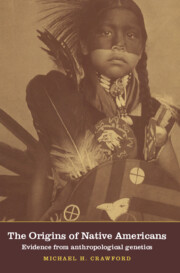Book contents
- Frontmatter
- Contents
- Preface
- Acknowledgement
- 1 Origins of New World populations
- 2 Population size and the effects of European contact
- 3 Demography of Amerindian populations
- 4 Genetic variation in contemporary populations of the Americas
- 5 Population structure of Native Americans
- 6 Morphological variation
- 7 The survivors
- References
- Author index
- Subject index
6 - Morphological variation
Published online by Cambridge University Press: 01 May 2010
- Frontmatter
- Contents
- Preface
- Acknowledgement
- 1 Origins of New World populations
- 2 Population size and the effects of European contact
- 3 Demography of Amerindian populations
- 4 Genetic variation in contemporary populations of the Americas
- 5 Population structure of Native Americans
- 6 Morphological variation
- 7 The survivors
- References
- Author index
- Subject index
Summary
INTRODUCTION
The history of physical (also known as biological) anthropology is intimately bound to the study of morphological traits and their uses in attempts to classify human races. Early physical anthropologists, such as F. Boas and A. Hooton, devoted much of their research energy to the collection of anthropometric data (body measurements) and anthroposcopic data (results of subjective grading of morphological characteristics that cannot be concisely measured) for the characterization of human races. Both the anthropometric and anthroposcopic traits have two distinct disadvantages in the study of human populations: (1) technical error (interobserver variation), which can be reduced to some degree in measurements and observations; and (2) ontogenetic changes in specific measurements, such as girth, height and weight. It is this ontological impermanence of measurements under changing environmental conditions that render anthropometries unsuitable for tracing long-term genetic relationships between the races. These problems associated with morphological traits are the major reasons that there was a ‘stampede’ by scientists to use the genetically based blood groups for evolutionary studies when methods for rapidly identifying these traits became available. The blood phenotypes remain unchanged throughout the life of the individual. Although there can be laboratory error associated with blood typing, this problem can be overcome by using independent determinations from two laboratories (Osborne, 1958). By the 1950s and 1960s, many American biological anthropologists had stopped utilizing anthropometric measurements in their studies of human population relationships.
The realization of the ecosensitivity (environmental responsiveness) of morphological traits shifted the use of these measurements from studies of race to those of processes of genetic–environmental interaction (Kaplan, 1954).
- Type
- Chapter
- Information
- The Origins of Native AmericansEvidence from Anthropological Genetics, pp. 194 - 238Publisher: Cambridge University PressPrint publication year: 1998
- 1
- Cited by



